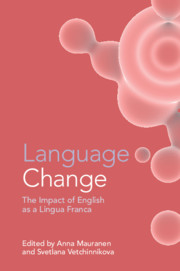Book contents
- Language Change
- Language Change
- Copyright page
- Contents
- Figures
- Tables
- Contributors
- Acknowledgements
- Abbreviations
- Introduction
- Part I Pooling Perspectives
- 1 Calling Englishes As Complex Dynamic Systems: Diffusion and Restructuring
- 2 English as a Lingua Franca in the Context of a Sociolinguistic Typology of Contact Languages
- 3 How Writing Changes Language
- 4 ELF and Translation As Language Contact
- 5 Present-Day Standard English
- 6 Beyond Language Change
- Part II Zooming in on ELF
- Index
- References
3 - How Writing Changes Language
from Part I - Pooling Perspectives
Published online by Cambridge University Press: 17 December 2020
- Language Change
- Language Change
- Copyright page
- Contents
- Figures
- Tables
- Contributors
- Acknowledgements
- Abbreviations
- Introduction
- Part I Pooling Perspectives
- 1 Calling Englishes As Complex Dynamic Systems: Diffusion and Restructuring
- 2 English as a Lingua Franca in the Context of a Sociolinguistic Typology of Contact Languages
- 3 How Writing Changes Language
- 4 ELF and Translation As Language Contact
- 5 Present-Day Standard English
- 6 Beyond Language Change
- Part II Zooming in on ELF
- Index
- References
Summary
Most linguists regard writing as an uninteresting and somewhat artificial add-on to spoken language. However, the availability of the written form influences language structure in profound ways at both the individual level (mental grammar) and the social level (language as a conventional system). The lexical and grammatical differences between spoken and written language are partly attributable to different contexts of use and partly to the fact that the written form provides a ‘processing crutch’ which enables speakers to produce more complex structures than they would otherwise be able to produce; structures which are initially learned with the aid of writing may then find their way into the speech of highly literate speakers. In the long run, the cumulative effects of these individual changes lead to changes at the level of the community language. Thus, languages with a long tradition of literacy, such as English, differ in substantial ways from oral languages.
Keywords
- Type
- Chapter
- Information
- Language ChangeThe Impact of English as a Lingua Franca, pp. 75 - 94Publisher: Cambridge University PressPrint publication year: 2020
References
- 1
- Cited by



